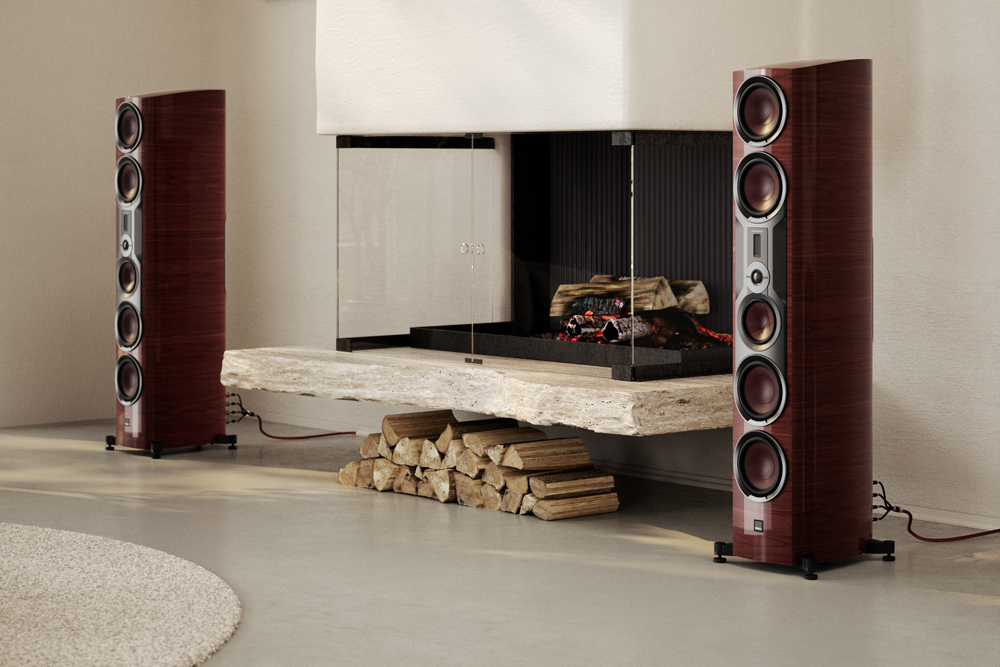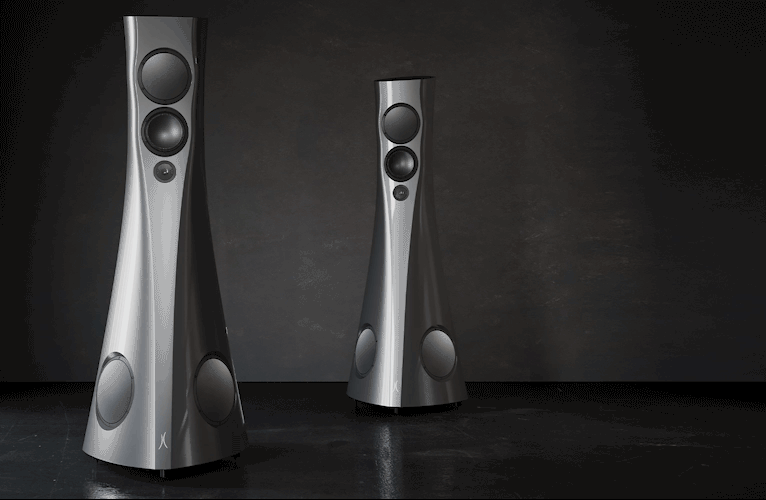I love Nordic design. The aesthetic simplicity, the elegance, the uncomplicated style. In audio, that near-minimalism belies a profoundly deep engineering intellect farmed from advanced public education. From folkeskole to University higher education, the system mines and develops social and technological advancement. The Danes are at the pinnacle, punching way, way above their mere six million population. In high-end audio, and likely other industries too, Denmark’s an authority. Driver design near-ubiquity and an abundance of powerful, prestigious brands collectively verges on market domination. DALI is the Danes’ biggest market-wide flag bearer, growing from a seedling, nurtured to evolved bloom, by the entrepreneurial spirit of industry trailblazer Peter Lyngdorf. And the Epikore 11 is the loudspeaker giant’s latest offering. Oh, and did I mention I’m a Nordic Noir fanatisk? Looking at you Sarah Lund and Birgitte Nyborg…
The Core of an Epic
It was mid-High End Munich 2023, on a trade day, when I made a point of attending the launch of DALI’s newest addition to the high-end audio loudspeaker space: the Epikore 11. Adroitly presented by company CEO Lars Worre, the Epikore 11’s towering, svelte stature, brimming with DALI’s latest driver tech, promised performance at the highest level. Worre talked about all the core aspects of the design, going on to play a variety of tracks, many from DALI’s own music catalogue.
The Epikore 11 sounded big, bold and dynamic, it exerted a presence in the room, it stated “I’m here, world, watch out!” I was equally impressed with Head of Product Management Krestian Pedersen’s presentation at the Tokyo International Audio Show (TIAS). Epikore 11 etched a deep sonic impression on my over-amassed experiential memory stockpiles.
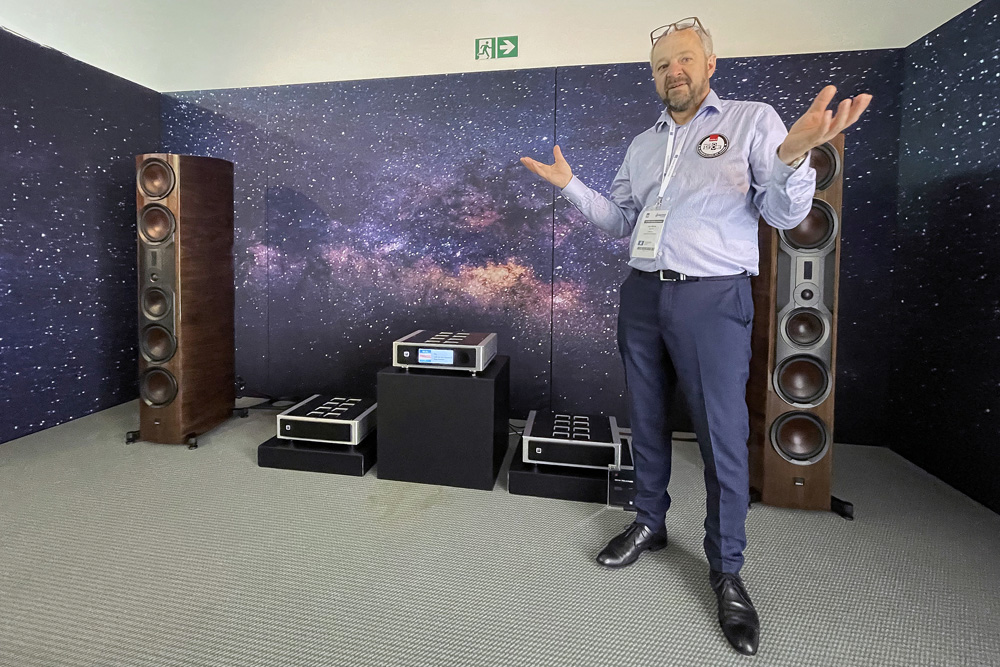
Forward a few months and SoundStage! Network founder Doug Schneider along with the Network’s gun videographers Chris Chitaroni and Jorden Guth visited DALI HQ in Denmark to illustrate the machinations at this highly successful and sophisticated loudspeaker maker by way of a slick InSight video (link here). Of course, this was a further enticement for my desire to review Epikore 11.
Following weeks of negotiations and scheduling to-and-fros with Karin Cahill, Marketing Manager at Australian importer Amber Technology, the E11s (for short) were finally delivered chez SoundStage! Australia December 2023.
DALI has transferred onto the Epikore 11 platform a significant level of technologies derived from the company’s KORE flagship. That tour-de-force speaker, in turn, was the result of an extensive Research and Development program dedicated to advancing and improving transducer, crossover and cabinet technologies. Epikore 11 is the recipient of those substantial advances.
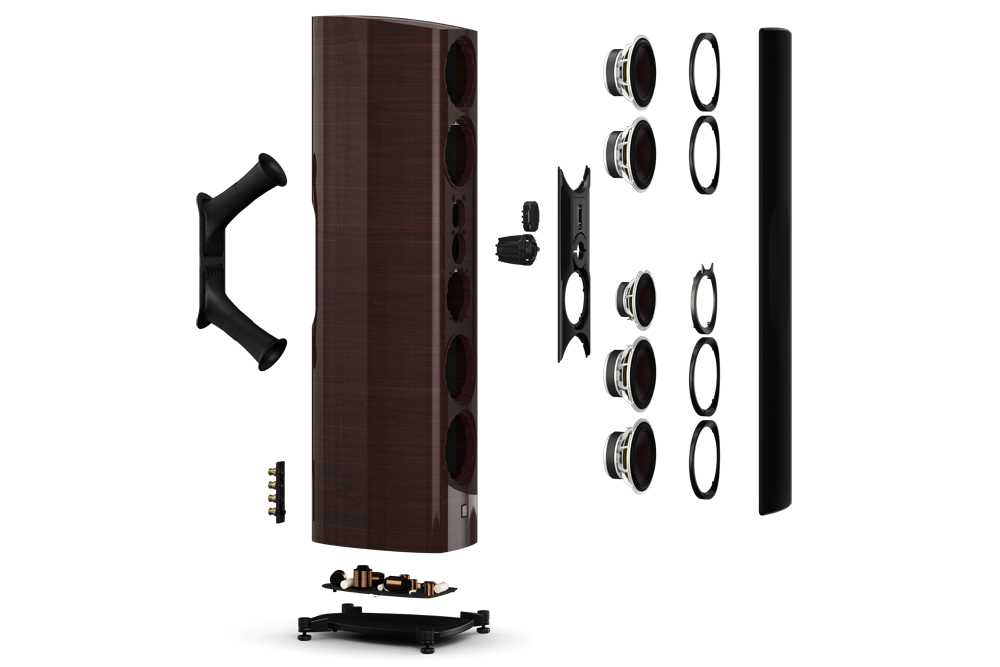
Starting with the drivers, DALI is one of the few manufacturers who develops and produces its own. That’s a lot. There’s tooling, materials development, labour intensive procedures, and a whole lot more involved in the manufacture of high quality transducers. For a company with the appropriate financial and production resources, creating bespoke drivers at differing technology levels provides tight engineering and quality control. You make them the way you really, really want/need them for each task.
E11 is a 4.5-way design featuring a seven-driver array. It comprises, from the top, two new 200 mm (8 inch) bass drivers, a bespoke 10 mm by 55 mm (0.4 by 2.2 inches) version of DALI’s renowned ribbon tweeter, a new and unusually large-sized 35 mm (1.4 inch) dome tweeter, a 165 mm (6.5 inches) midrange driver, and a further dual 200 mm (8 inch) woofers. That’s a lot of moving surface area right there, promising good bass power and depth in the low registers (reinforced via large double reflex ports) and good top-end extension and presence in the high frequencies.
A unique feature of DALI speakers is the coupled arrangement of ribbon and dome tweeters, which the company has employed across many of its upmarket models for several generations (I believe since 1990). DALI calls this hybrid tweeter system EVO-K and it forms the core of DALI’s ‘Wide Dispersion Sound Design Principle’. The ribbon driver is a refinement of the one used in the upper-tier Epicon line.
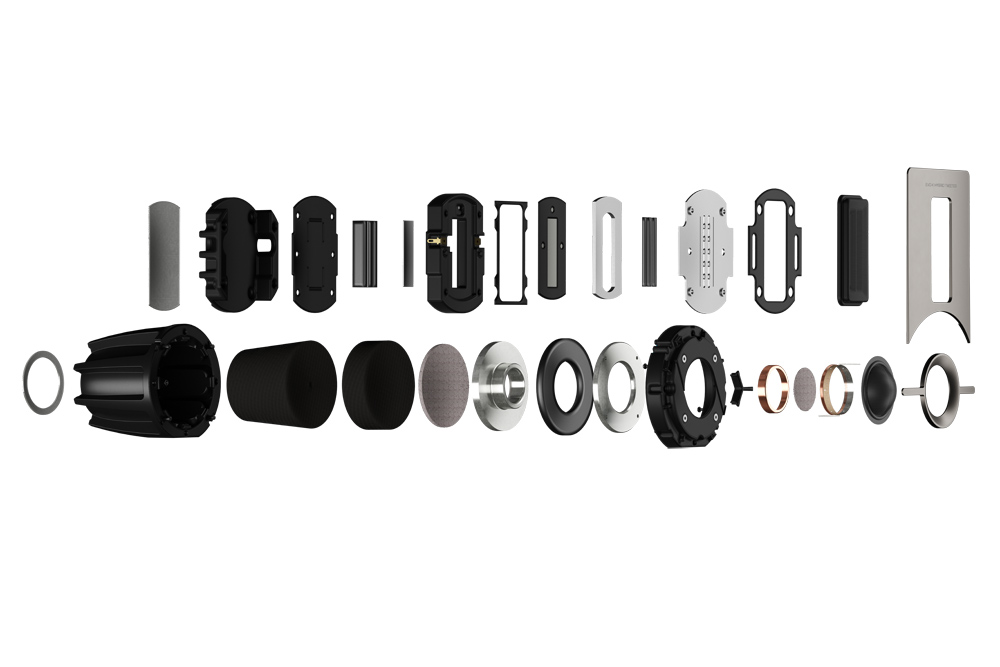
The company’s engineers have designed the planar magnetostatic ribbon for a slow roll-in at around 10 kHz, then coming into full adoption from 12 kHz to its upper register at 34 kHz. It features a premium-grade Neodymium-Iron-Boron system, an improved rear waveguide and new rear-mounted aluminium heatsink allowing higher output. That same higher output is also due to the lowered induction of the voice coil and magnet system via a cap on the copper pole piece.
The new EVO-K 35 mm soft dome tweeter’s larger-than-is-common dimensions are due to the engineers seeking a higher power output (lower compression) at the driver’s lower frequency range and lower overall distortion. The larger diameter is also said to provide a lower resonant mode which simplifies the crossover design and the inter-driver blending. DALI eschews ferrofluid due to its “viscous damping” properties which can slow down the tweeter’s transient response due to a potentially slower voice coil excursion velocity. The EVO-K tweeter is housed in a dedicated conical cast aluminium enclosure featuring a damping material designed to control the rear wave radiation.
DALI has developed a special ‘SMC’ (Soft Magnetic Compound) material used across all its upmarket midrange and bass drivers. SMC Gen-2 is a coated, “granular magnet material” which can be machined to just about any shape required for its function. When used around driver magnet motors, its combination of “very high magnetic permeability and very low electrical conductivity (approximately 1/10,000th of iron)” resulting in remarkably low electro-acoustic distortion. On Epikore 11 – and introduced in the flagship KORE – it’s the second generation SMC Gen-2 which runs through the centre of the voice coil and attaches to the back plate while also being used radially on the front plate near the magnet gap.
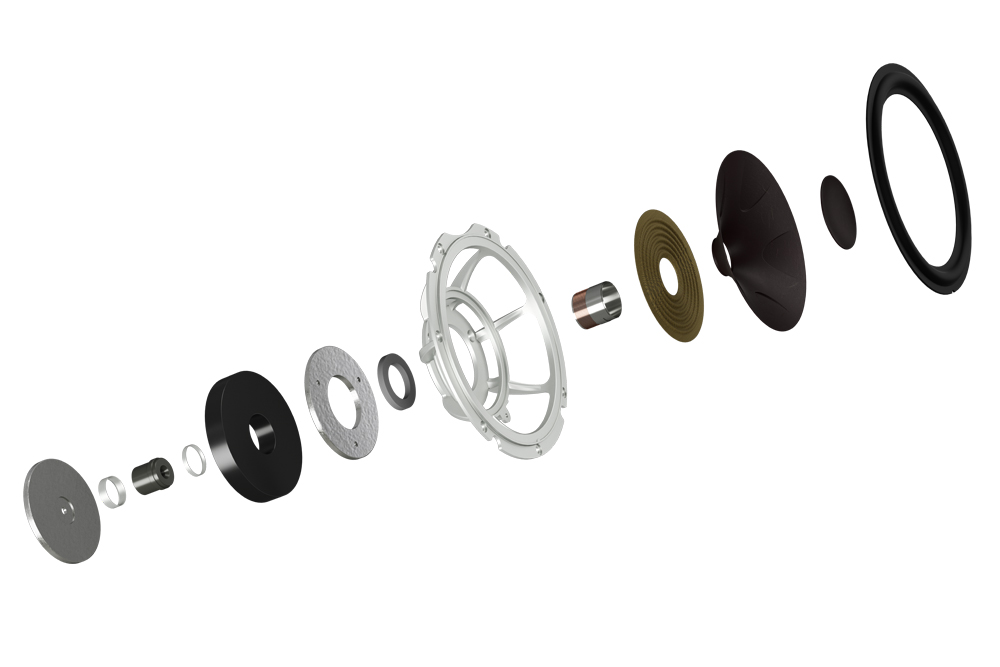
The E11’s 165 mm midrange driver is also derived from KORE. It features a large, titanium former voice coil (of course, with SMC Gen-2 material within) and powerful magnet system driving an embossed paper and wood fibre composite diaphragm. The cone’s geometric embossing, in conjunction with a special hand-applied damping lacquer, acts to control break-up and resonance modes without adding extra weight. DALI states it has also employed “aluminium flux demodulation/inductance linearisation rings within its magnet system” in order to reduce flux modulation distortion.
Yeah, there’s a lot to talk about regarding E11’s woofers, even if, for brevity, I’m only covering 50 percent of what’s involved. DALI’s white paper covers extensive details on all the drivers and dedicates a number of pages for the woofers’ design, engineering and technical abilities aimed at low-distortion, high power, extended range, and elevated dynamics.
Epikore 11’s four new 200 mm bass drivers are symmetrically mounted two above and two bellow the highs-and-midrange array. Again, there have been substantial engineering efforts to reduce distortion, especially with the higher levels inherent in powerful woofers. The woofers feature wood fibre and paper composite diaphragm terminated with a large rubber roll surround. The super-rigid titanium 38 mm ventilated voice coil is driven by a “massive” ferrite magnet system while the whole construction is supported by a newly designed basket architecture. The rigidity of titanium has allowed the use of a larger than usual voice coil ventilation system which, of course, improves heat dissipation and increases power handling.
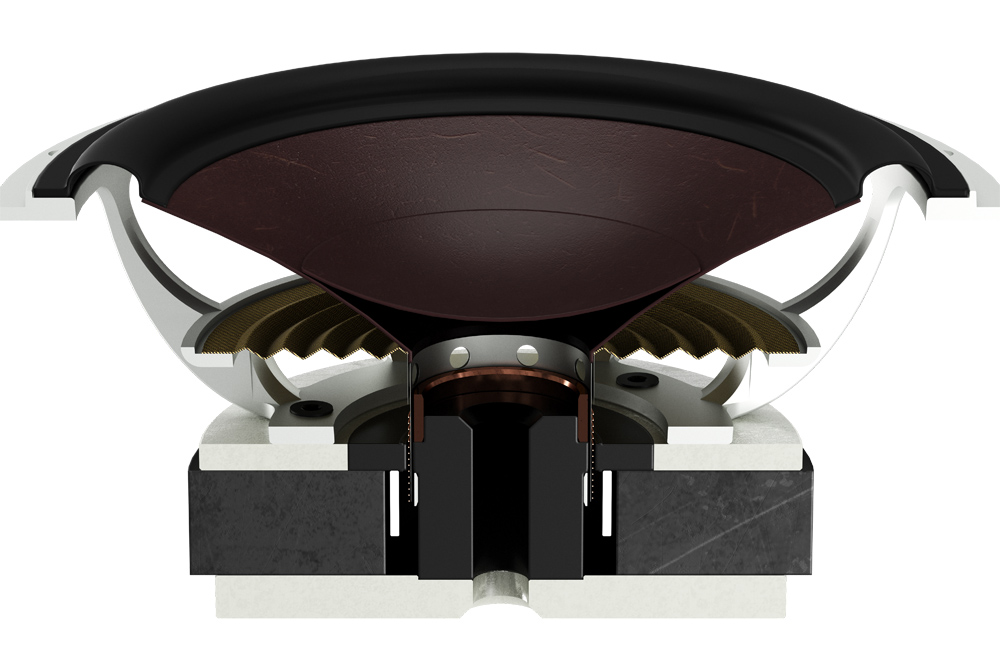
The woofers are supported via a distinctive rear-firing reflex port system. Each pair of woofers are housed in dedicated enclosures (64 litres) with the long, flared ports placed relatively close to the woofers rear magnet system. This is said to control propagation time delay while the continuous subtle flare along the ports’ length, along with steeper inner and exit flares, serves to control resonance, chuffing and port noise. The ports are tuned to a low 24 Hz in order to minimise group delay.
DALI has applied what it calls ‘Floor Reflection Control Technology’ (FRC) which, deals with floor reflection issues across the low frequencies. Simplistically for the purposes of this review, floor reflections can cause a cancellation in the 250 Hz to 300 Hz sector. DALI engineers have placed the acoustic centre of the upper pair of woofers slightly behind the centre of the lower pair. This simple technique is said to fill-out that narrow bandwidth cancellation while also “tilting” the woofers’ radiation lobe marginally upwards and away from the room’s floor. Clever.
The best drivers in the world aren’t worth their salt without a well-engineered crossover network. DALI has dedicated considerable efforts to make the crossover as efficient as possible in order to blend the drivers seamlessly. DALI states, “high-pass and low-pass filters are designed to achieve specific acoustic frequency and phase response targets…” The DALI engineers have designed a low-pass filter of the upper pair of woofers which is slightly lower in frequency compared to the lower pair (that tilting lobe again). These and other aspects of the crossover design were arrived at via extensive subjective listening, not merely through technical aspects. Employed in the crossover were high quality custom components, derived from KORE, and oxygen-free multi-strand copper wiring for the driver and binding posts interface. Said binding posts are superbly built and offer bi-wiring/bi-amping options.
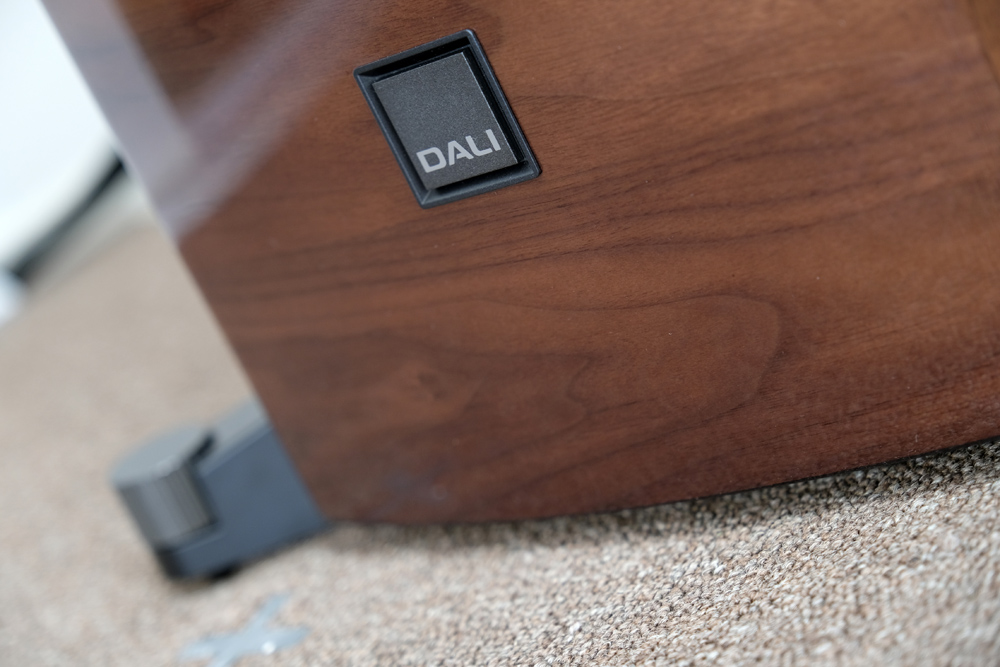
Finally, the cabinet is a thing of both technical excellence and beauty. As mentioned above, each pair of woofers is housed in its own dedicated, 24 Hz-tuned sub-enclosure while yet another sub-cabinet houses the midrange driver. All have been volume-optimised to provide the best environment for the drivers. Thick MDF forms the curved side panels while 40 mm MDF baffles are the mounting points for the woofers. The midrange and tweeter array is mounted on its own aluminium die-cast baffle. There’s a substantial bracing scheme to reinforce the already stiff curved panels which also serve to control internal standing waves. Vibrational distortions and augmented stiffness are provided by strategically-placed bitumen damping panels.
OK, I’ll state the obvious. DALI’s Epikore 11 is a tour-de-force of loudspeaker design. There are precious few companies in the loudspeaker market who can produce this level of technology under the one roof. Kudos.
Quick specifications run through. DALI states the Epikore 11’s frequency response to span from 29 Hz to 34 kHz +/- 3dB, the impedance as nominally 4 ohms and the sensitivity at 89dB at 1 watt/2.83V. Maximum SPLs are said to be 116dB. Each speaker weighs 75.6 kg.
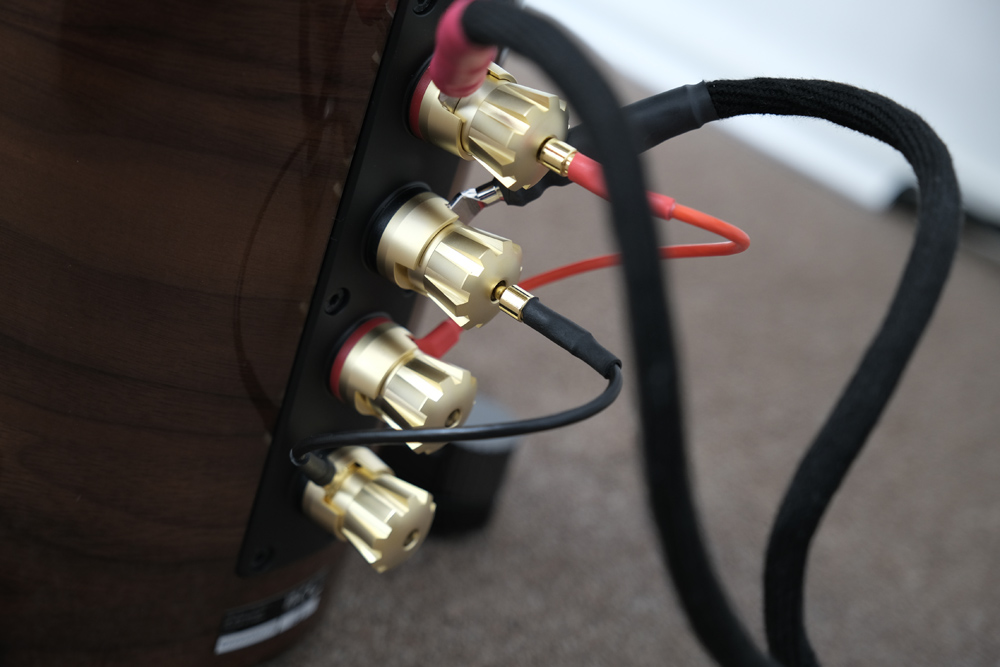
Fit and finish is first-class and the gloss lacquer is applied flawlessly. The outrigger footers are of high quality and I’ve already talked about the binding posts system which is top-notch. Epikore 11 is available in High Gloss Black, High Gloss Walnut and High Gloss Maroon finishes. The Walnut review sample was gorgeous.
An Interview DALIance
During his visit to Australia, I met up with DALI’s APAC Regional Director Gilles Brun. Brun further detailed some of Epikore 11’s key aspects.
We’ve used all the technology from the KORE and scaled them down to the Epikore. We’ve used SMC Gen-2 technology on the midrange and all the woofer drivers to reduce distortion and mechanical losses. It uses a granular powder which we can shape into different parts. The material eliminates eddy currents and is purely magnetic. With the high frequencies, both the ribbon and the dome tweeter are larger than usual to extend their frequency range. The 38 mm dome tweeter goes lower in frequency and above that the ribbon tweeter takes over naturally. It’s a nice blend and we can benefit from the openness of the ribbon tweeter and the characteristic of the soft dome tweeter. So, this is the EVO-K array which is the same as in KORE.
I was curious as to how long Epikore 11 took to developed, especially in light of KORE.
Well, much shorter than usual. We did all the hard work with KORE. So it was a matter of scaling down. We still had to sort out the components, the cabinet engineering, the finishes. This is a complete product. From A to Z, it took just over a year. We do everything in Denmark. Yes, yes, we do the finish, we use robots to do the brushing and lacquering.
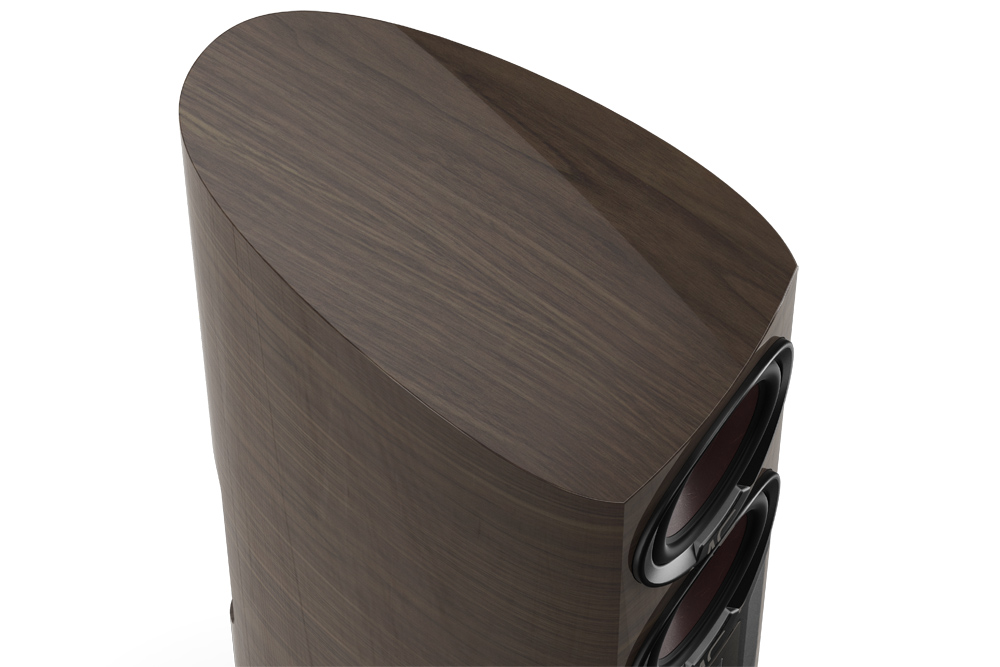
This next one is less to do with Epikore 11 and more of a general interest for music lovers and audiophiles. In that same InSight video I linked above, DALI CEO Lars Worre tells Doug Schneider about his appreciation of the sound quality of the CD. DALI has a range of CD compilations, of which two or three of them I periodically personally use for product reviews. I asked Gilles what role the CDs play in the development of the company’s speaker products.
Those recordings have two kinds of purposes. The first one is to establish a kind of reference for both DALI and the customers. With the music variety, we voice the speakers so they work for everything. We don’t develop speakers that suit this kind of music and not that one. Those tracks are used so we are always listening to the same music, or source, when comparing things. When we look at a response curve we’re only seeing a percentage of what we can hear. There are things like phase, time alignment and other things that we hear as human beings and, sometimes, sometimes, we cannot measure things. We need to be true and honest.
In light of DALI celebrating its 40th Anniversary, I asked Brun what, in his opinion, were some of the highlights and standouts through the four decades.
Oh, there are so many. You know, DALI started from nothing by Peter Lyngdorf. It came from a need to make its own speakers through the ‘Golden Age’ of Hi-Fi in the late 70s, beginning of the 80s. A lot of brands appeared at that time. We went through many stages over the last 40 years. There were key products, with different technologies like Megaline. But we started with simple speakers and then we started to bring technology in; that has been the major journey. About 15 years ago we established our own factory, DALI Ningbo, China. They produce some product components for the Danish factory.
We also established our own distribution when and where it makes sense. China has been a major step. There is DALI Germany, DALI France, DALI UK and some others. Five years ago, we established DALI APAC for about 15 countries with our home base in Malaysia. From our warehouse in Kuala Lumpur, we are able to supply 80 or 90 percent of APAC.
What sums up DALI, I asked Brun.
We strive to provide honest, value for money speakers. We can have some better some lesser speakers, some more expensive or less, but what we strive for is to provide value at each level and aim for the best-in-class. What you pay is what you will get. That’s our motto. This is what drives us.
Epik Mission
Operation Epikore 11 was accepted, delivered and installed by special agents Martin Ireland, Amber Technology National Sales & Marketing Manager and Brand Manager Andrew Richter. These guys are tall. For an idea of scale, a comparison of speaker-against-tall-human, check-out this Instagram post (and also here) where the gents are doing the DALI dance with Epikore 11.
In my room, the E11s make quite the statement. As I said earlier, at 1.6m high, they are nicely proportioned with a slightly deeper 554 mm in relation to the svelte 422 mm width. Towers is what they indeed are. And while their dimensions make for a pleasing elegance, the level of fit-and-finish reflects DALI’s desire to offer a product which confidently manifests itself as a contender in the upper tier high-end loudspeaker market.
The Amber Tech gents were super-efficient in installing the hardware supplied with E11. There are four outrigger footers per speaker which need to be bolted onto the bottom plate. They accept a spiking system which can be conveniently and easily adjusted from above with the provided Allen key. Trim caps, or ‘thumbscrew lock nuts’ as DALI refers to them, are also provided to dress the top of the spikes and to present a more finished, better looking aesthetic.
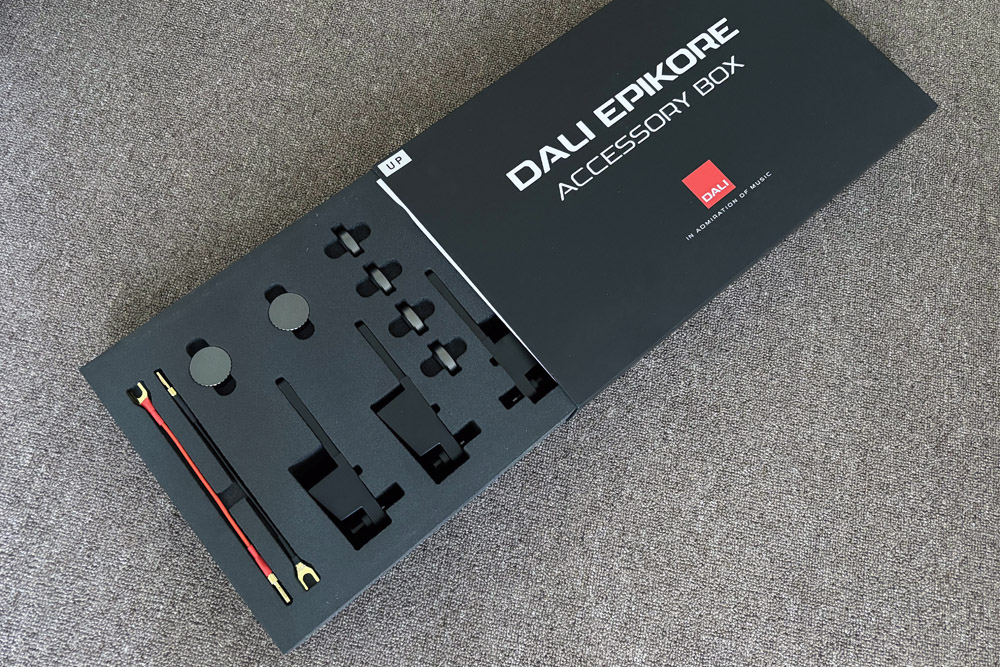
The accessories kit – one box per speaker – also includes the terminal jumpers for single-wiring configuration. As is common practice, they feature banana plugs at one end, and spades at the other. Also in the kit, you’ll find nicely machined, solid metal floor protecting pucks which, of course, couple to the spikes and feature a soft underside. From memory, I haven’t come across this before, but the pucks attach to the spikes magnetically. Nice touch.
After some preliminary, non-analytical listening sessions, where the DALIs were placed in the approximate location where most speakers land for best performance, I felt that although good, E11s could offer yet more. DALI recommends a zero toe-in and an equilateral triangle configuration between speakers and listening position for best soundfield rendition. That last point meant I needed to move my listening position a tad closer to the plane of the speakers. While performing the chair shuffle boogie, I also discovered the listening height in relation to the tweeter/s played an important part in terms of fleshing out and balancing the highs with the midrange. In my room, at least, a vertical off-axis variation of a few inches makes a difference and proper height alignment brings out the slightly recessed midrange I heard when off-axis.
Epikore 11s provide a sound which was somewhat different to anything I have heard before from the many dozens of speakers I’ve reviewed over the years. I think it’s the midrange perspective, which I’ll call ‘mid-hall’.
So, first, you hear a clear-as-day top end where detail is phenomenal, yet without etch or brightness of any kind. Then, there’s that massive, subtly rounded, full-bodied bass which is also remarkably deep.
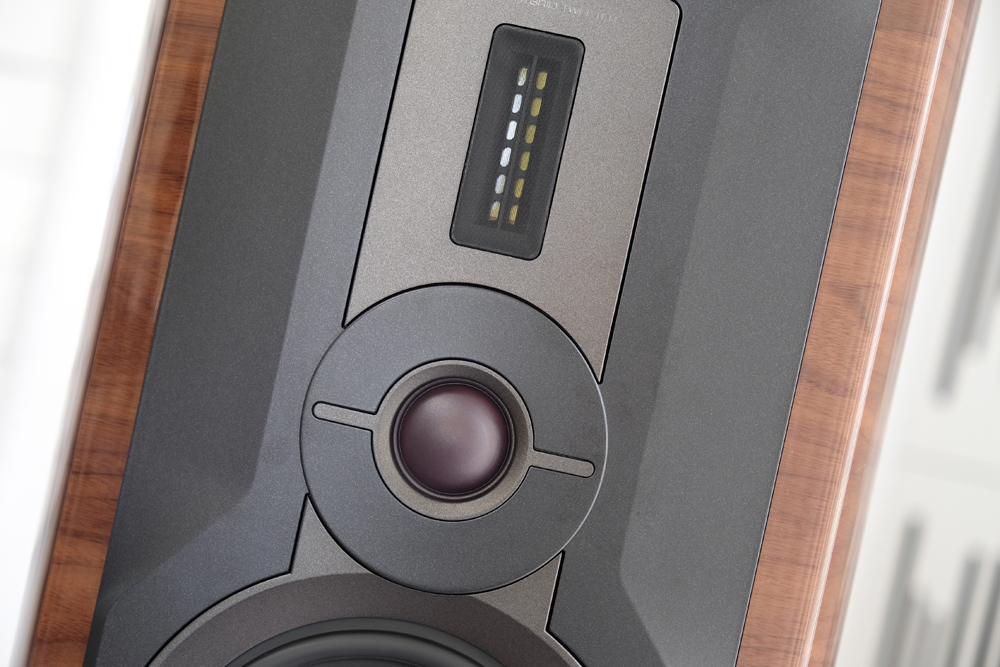
Those two properties tallied together with a natural midrange which puts the listener in that mid-hall perspective I refer to. The purity of the highs and the marginally laid-back midrange make for stunning, life-like vocals placed just behind the speakers’ plane. I marvelled at the immediacy and intimacy of Sophie Zelmani’s close-miked “I Love You” from her Soul album on Qobuz. Through the Epikore 11s, Zelmani’s gentle articulation and almost whispered intonation just about put her in the room, as audiophiles like to say. E11s’ clarity and transparency, as handled by that glorious dual tweeter and midrange array, is truly remarkable. I actually discovered this album while listening to E11s for evaluation. Once E11s had their way with this recording, my immediate reaction was: “Added to Library”.
The same vocal clarity and in-room mirage was manifested via Lhasa (Lhasa de Sela), from her self-titled album. On “Love Came Here” Lhasa was imaged tightly in the centre and just a tad back from the line of the speakers while the backing band seemed to position the rear of the soundstage. The soundfield, in fact, was tremendous. I spread in all planes but, in particular, in the depth perspective where the soundstage was as deep as I’ve ever heard and on par with my considerably pricier reference. Way beyond the front wall. Outstanding.
As far as high frequency drivers, ribbons are just about king when it comes to detail and transient attack. I was consistently amazed at E11’s profound levels of detail across well-produced acoustic instruments. Spin a skilled guitarist, like Sylvain Luc playing a cover of The Doors’ “Light My Fire” from his album Joko and you’ll hear astonishing micro-dynamics with sublime leading edges to the notes. Effectively, at the listening chair, that translates to an elevated level of realism, and even a ‘jump factor’ which startles through aggressive plucking and strumming. Those qualities, combined with excellent tonal truthfulness and guitar string harmonics, make for a grand musical experience.
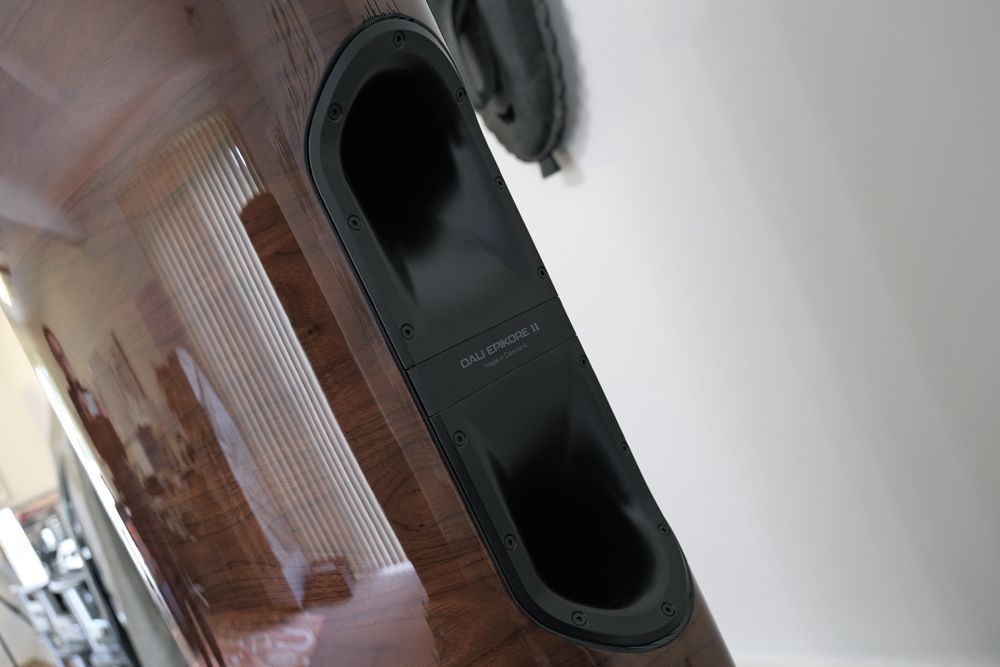
Given the astounding soundfield dimensionality, I had to spin and stream big orchestral pieces. I have a decent collection of vinyl from the Deutsche Grammophon label. Many are mint German pressings. Great recordings with some of the best orchestras on the planet conducted by von Karajan, Abbado, Rostropovich and others. It’s with these iconic recordings where Epikore 11s were truly exceptional. I wholeheartedly agree with DALI’s recommendation of zero toe-in orientation. Positioned that way, I was presented with a phenomenal soundfield which spread way beyond the speakers, especially in that depth dimension I mention above. The Berliner Philharmoniker under von Karajan, with Anne-Sophie Mutter tackling Brahms’ Violin Concerto, was an exercise in dimensionality and sweet string tone. Tonally, the ribbon and dome play seamlessly.
Can the Epikore 11s rock? Yeah, sure. The distinct, mid-concert hall presentation (as opposed to first rows perspective) coats the midrange with a super-fine film of politeness. The four SMC woofers contrast that with dynamic, rounded and detailed low-frequencies which propel bass lines and fill-out the electric guitars’ lower tones. Play any of Tool’s releases – “Parabola” from Lateralus, for example – and you’ll know exactly what I mean. Plus, I have seldom heard Lenny Kravitz’s “Sister”, from his analogue recorded Are You Gonna Go My Way album, as full-sounding and utterly satisfying as through Epikore 11. One an existential saga, the other a deliciously retro listening experience.
Of course, I had to try one of DALI’s wisely compiled CDs. From The DALI CD Volume 4 I played Danish jazz group Vestbo Trio’s “Mudslide” (originally from the trio’s While You Were Gone album). The delicate clarity mixed with exceptional resolution and precise tonal qualities across the bandwidth provided a clear insight into each of the instruments while also retaining the holistic vibe of the track.
On that same CD, the ‘liveness’ of James Blood Ulmer Live Experience’s “Crying” from the album Live at the Bayerischer Hof was impressive, E11s’ rendition of the venue’s acoustics and the audience’s in-room presence were both vivid and natural. The separation between Ulmer’s hectic guitar antics, his unique voice, and the rest of the band – specifically the electric bass and drums – was noteworthy, yet not in a way that surgically dissects the coherence, and the excitement, of the track.
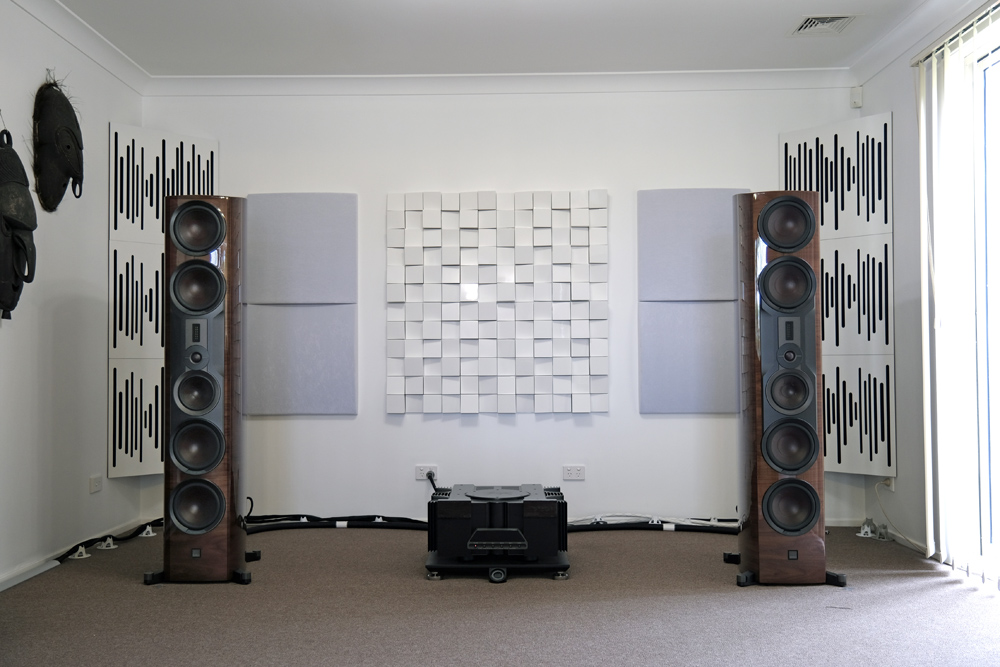
Conclusion
Yeah, Danish companies exhibit principles which are almost universally shared across this country’s audio product manufacturing. It’s a model, or a culture, of high engineering intelligence, advanced manufacturing capabilities, and deep market understanding. In DALI’s case, the Danish model has translated to an enterprise which is placed in the ‘Magnificent Seven’ of the audio industry.
Like all industry leaders, DALI needs a principal product, a hero line. After a short hiatus from audio’s upper echelons, DALI shakes the sector. First, with the KORE flagship. Then, it trickles much of that state-of-the-art technology to it’s younger and smaller sibling, the Epikore 11, which now serves as a recon scout and guide for further models to come.
Epikore 11 is quite the engineering feat. Its in-house designed, distortion-minimised dual tweeter arrangement is among the best in the business. It plays coherently with exceptional detail and zero brightness. The midrange is pure and true, and the woofer drivers do low frequencies with astounding power, nuance and depth. I found the Epikore 11’s presentation, especially with large orchestral works, to be among the most accomplished in the high-end space.
There’s an impression of investment security, of intrinsic value (even at the price point), and of potential personal satisfaction which are inherent traits of Epikore 11. It’s a product of one of the world’s largest loudspeaker manufacturers and a manifestation of skilled engineering and advanced materials as the prime design direction. Beyond technical aspects, Epikore 11 is gorgeously styled and finished. I reckon sit back, play your favourite tunes, and just enjoy the journey. With Epikore 11, you’ll have a most reassuring, music-nurturing partner.
… Edgar Kramer
This email address is being protected from spambots. You need JavaScript enabled to view it.
Associated Equipment
- Speakers — Wilson Audio Alexia V, Axis Loudspeakers VoiceBox S (nearfield monitor), Vermouth Audio Little Luccas Mk.II, Atacama stands
- Amplifier — Gryphon Audio Antileon EVO
- Preamplifier — Supratek Cortese, Totaldac d1-triunity (direct to amplifier)
- Sources — Digital: 432 EVO Aeon Mk.3 Reference Music Server/Roon Core, Yamaha CD-S2100 transport, Totaldac d1-triunity DAC. Analogue: Transrotor Crescendo with Konstant Studio controller, Reed 1X Tonearm with upgraded internal wiring, Shelter Harmony cartridge, The Funk Firm Houdini cartridge decoupler, Supratek Cortese & REDGUM Audio RGPH2 phono stages
- Processor — DEQX PreMate (part of arsenal/casual use)
- Cables — VYDA Laboratories Orion Silver Reference HFC IC and speaker cables, PSC Audio custom design XLR, Vermouth Audio Reference loom,ZenSati Zorro, Tubulus Concentus USB
- Audio Rack — SGR Audio Statement Model V, Aspire Audio Belgravia amplifier platform (customised for Gryphon Audio Antileon EVO), Stereotech Aluminar Dark 3-tier rack
- Acoustic Treatment — Vicoustic Multifuser Wood, Wavewood Ultra, Cinema Round Premium and Super Bass Extreme
- Miscellaneous — Silent Angel Bonn N8 Pro network switch, GigaWatt PF-1 EVO power strip, Les Davis Audio Viscoelastic CLD discs, VRC Vinyl Record Cleaning system plus miscellaneous accessories
DALI Epikore 11 Loudspeakers
Price: AU$84,999
Australian Warranty: Five Years
Australian Distributor: Amber Technology
+61 (02) 9998 7600
www.ambertech.com.au
DALI A/S
Dali Allé 1
Nørager
Nordjylland 9610
Denmark
+45 9672 1155
www.dali-speakers.com






